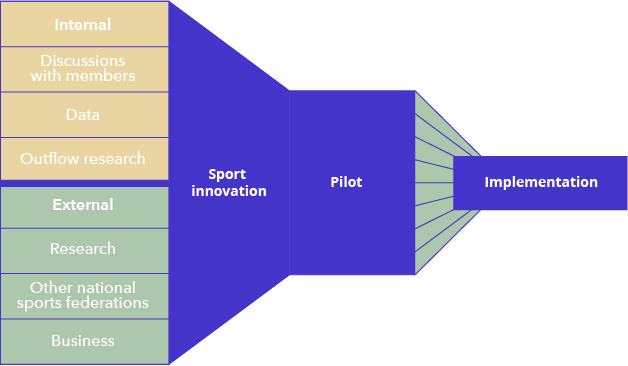CASE
STUDY
Reimagining Sports participation
Case study
Innovation within Dutch national sport federations
Researched by Sven Schuitemaker
In 2016, the Paris Agreement on climate change was signed with the aim of limiting global warming to 2 degrees Celsius (United Nations, n.d.). The Netherlands also agreed to this accord and subsequently formulated the Dutch Climate Act, which applies to Dutch sports stadiums as well. Due to the significant ecological impact of sports stadiums, including factors such as fan travel and waste production, it is necessary to take measures in this area. This research examines the current status of ecological sustainability in Dutch sports stadiums, identifies the key challenges they face, and explores innovative solutions to reduce their ecological footprint. The findings of this study can contribute to a more sustainable future for sports stadiums. The following research question has been formulated for this research: What is the current status of ecological sustainability in Dutch sports stadiums, and what are possible innovative solutions to reduce their ecological footprint and become more sustainable? (Schuitemaker, 2023).
Methodology
Qualitative research with semi-structured interviews
- 10 staff members of different national sport federations, who have something to do with innovation in their work.
- 1 interview with a staff member of NOC*NSF.

Methodology
Qualitative research with semi-structured interviews
- 10 staff members of different national sport federations, who have something to do with innovation in their work.
- 1 interview with a staff member of NOC*NSF.

Key Insights
- There is no one golden way that works to suddenly engage all 12- to 18-year-olds. It is a complex problem where multiple solution scan contribute to binding the target group.
- There are internally and externally-oriented reasons why this group drops out of sports associations.
- The most important recommendation remains to stay in good dialogue with members at all times and put their wants and needs first. That is going to yield the most results for member retention.
Key Insights
There is no one golden way that works to suddenly engage all 12- to 18-year-olds. It is a complex problem where multiple solution scan contribute to binding the target group.
There are internally and externally-oriented reasons why this group drops out of sports associations.
The most important recommendation remains to stay in good dialogue with members at all times and put their wants and needs first. That is going to yield the most results for member retention.
Field studies
Factors which influence the configuration of a sport innovation and process before implementation in a Dutch national sports federation

Final Results
There is little literature on the use of data during the scouting process within elite sports in the Netherlands.
The study shows that in different organisations, different ways are being used to scout players. In general, a distinction can be made between sports federations and sports clubs.
The research shows that respondents consider it important to remain objective in the scouting process. The use of data helps scouts to make a better risk analysis, view more players in a shorter period of time and scouting trips can now be used in a more targeted way to watch specific players.
Potential objections the respondents see to the use of data are the following: a. data can be misinterpreted and organisations may focus too much on the data b. not taking enough account of humanity and other factors in a player’s environment.
The elite sport organizations being questioned currently using mainly descriptive and diagnostic analysis on the data. This means that games and situations in training are being described, reported and investigated on why certain situations occur.
According to the respondents, there is potential in the development in artificial intelligence. They want to use this to gain more insight to the influence of other players on the performances of one specific player. Data will then have more predictive and prescriptive value.
Top sports organisations are recommended to research the details of European data privacy legislation and create a structure for data flows so that only the right people can access athletes’ personal data.